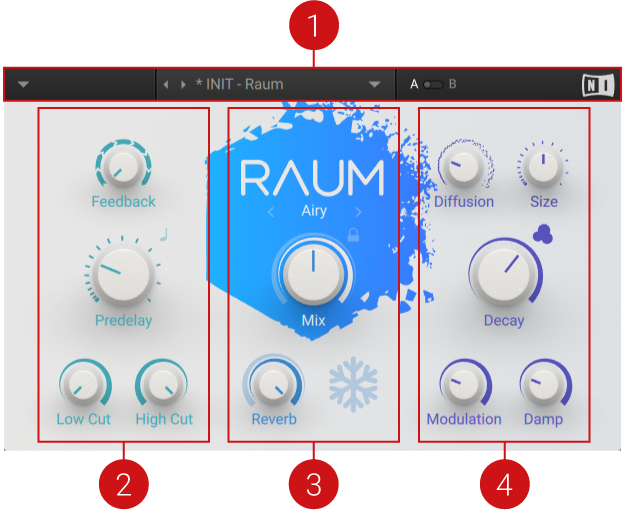Overview of RAUM
RAUM groups its parameters in three sections: predelay and filter, global controls, and the reverb algorithm.
The user interface of RAUM provides a clear overview of all parameters by grouping them in three sections: On the left side, you can adjust parameters related to the initial processing of the input signal, including predelay and equalization. In the center, you can find global controls for selecting the reverb algorithm, setting the effect amount, and activating the Freeze function. On the right side, you can tweak the selected reverb algorithm in detail. The header at the top allows you to save and load presets as well as change the plug-in settings.
The following overview shows the basic structure of the effect:

Header: Provides global functions related to preset management and plug-in behavior. For more information, refer to Header and Presets.
Predelay and Filter: Parameters related to the initial processing of the input signal. You can adjust the timing of the reverb's onset with Predelay or use it in combination with Feedback for echo effects. The Low Cut and High Cut filters allow you to adjust the overall tone of the effect as well as the predelay's delay repetitions. For more information, refer to Predelay and Filters.
Global controls: Parameters related to the basic behavior of the effect. You can select one of three different reverb algorithms that cover a vast range of reverb sounds and can be further edited in the right side of the plug-in. The Mix and Reverb parameters adjust the global effect amount and the reverb amount, respectively. The Grounded and Airy algorithms additionally offer the Freeze function that holds the reverb's sound content for as long as the it is activated. For more information, refer to Global Controls and Freeze.
Reverb algorithm: Parameters specific to the selected reverb algorithm. You can change the length of the reverb (Decay) as well as control the consistency (Diffusion) and distribution (Size) of the reflections. Modulation adjusts the amount of movement applied to the reverb effect, while Damp adjusts the tonal quality of the sound. For more information, refer to Reverb Algorithms.